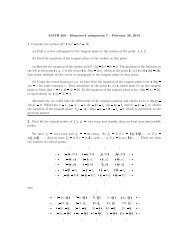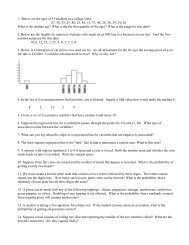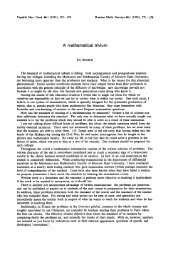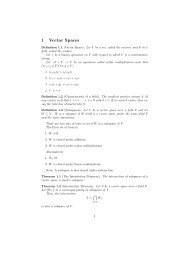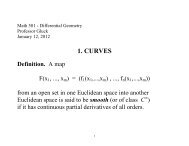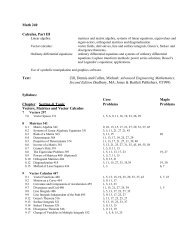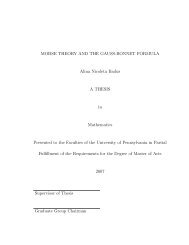Barcodes - Department of Mathematics
Barcodes - Department of Mathematics
Barcodes - Department of Mathematics
Create successful ePaper yourself
Turn your PDF publications into a flip-book with our unique Google optimized e-Paper software.
4 ROBERT GHRIST<br />
Cǫ<br />
ǫ<br />
Figure 2. A fixed set <strong>of</strong> points [upper left] can be completed to<br />
a a Čech complex Cǫ [lower left] or to a Rips complex Rǫ [lower<br />
right] based on a proximity parameter ǫ [upper right]. This Čech<br />
complex has the homotopy type <strong>of</strong> the ǫ/2 cover (S 1 ∨ S 1 ∨ S 1 ),<br />
while the Rips complex has a wholly different homotopy type (S 1 ∨<br />
S 2 ).<br />
needed for a Čech complex. This virtue — that coarse proximity data on pairs <strong>of</strong><br />
nodes determines the Rips complex — is not without cost. The penalty for this<br />
simplicity is that it is not immediately clear what is encoded in the homotopy type<br />
<strong>of</strong> R. In general, it is neither a subcomplex <strong>of</strong> E n nor does it necessarily behave<br />
like an n-dimensional space at all (Figure 2).<br />
1.4. Which ǫ? Converting a point cloud data set into a global complex (whether<br />
Rips, Čech, or other) requires a choice <strong>of</strong> parameter ǫ. For ǫ sufficiently small,<br />
the complex is a discrete set; for ǫ sufficiently large, the complex is a single highdimensional<br />
simplex. Is there an optimal choice for ǫ which best captures the<br />
topology <strong>of</strong> the data set? Consider the point cloud data set and a sequence <strong>of</strong> Rips<br />
complexes as illustrated in Figure 3. This point cloud is a sampling <strong>of</strong> points on<br />
a planar annulus. Can this be deduced? From the figure, it certainly appears as<br />
though an ideal choice <strong>of</strong> ǫ, if it exists, is rare: by the time ǫ is increased so as<br />
to remove small holes from within the annulus, the large hole distinguishing the<br />
annulus from the disk is filled in.<br />
2. Algebraic topology for data<br />
Algebraic topology <strong>of</strong>fers a mature set <strong>of</strong> tools for counting and collating holes<br />
and other topological features in spaces and maps between them. In the context <strong>of</strong><br />
Rǫ



